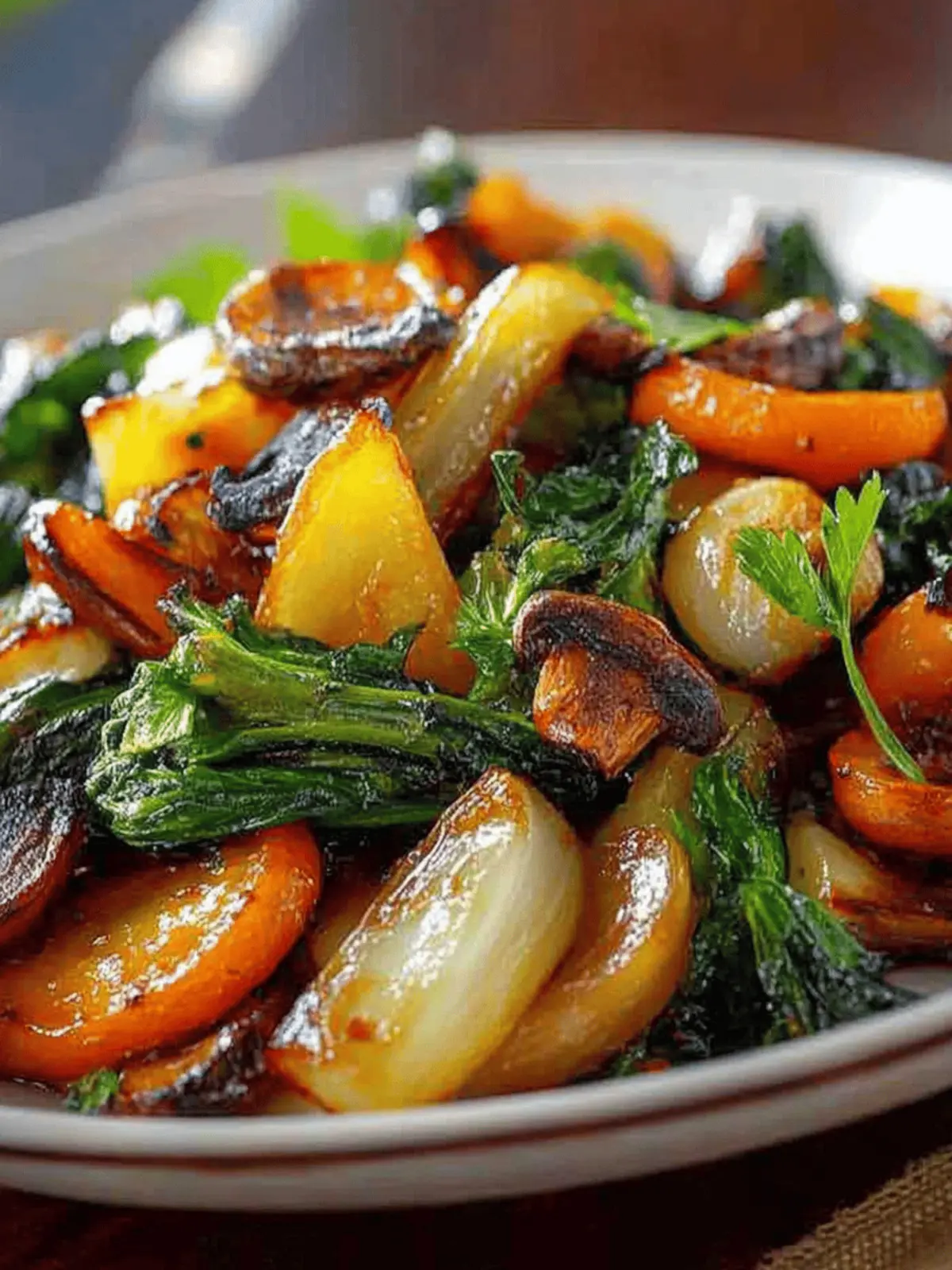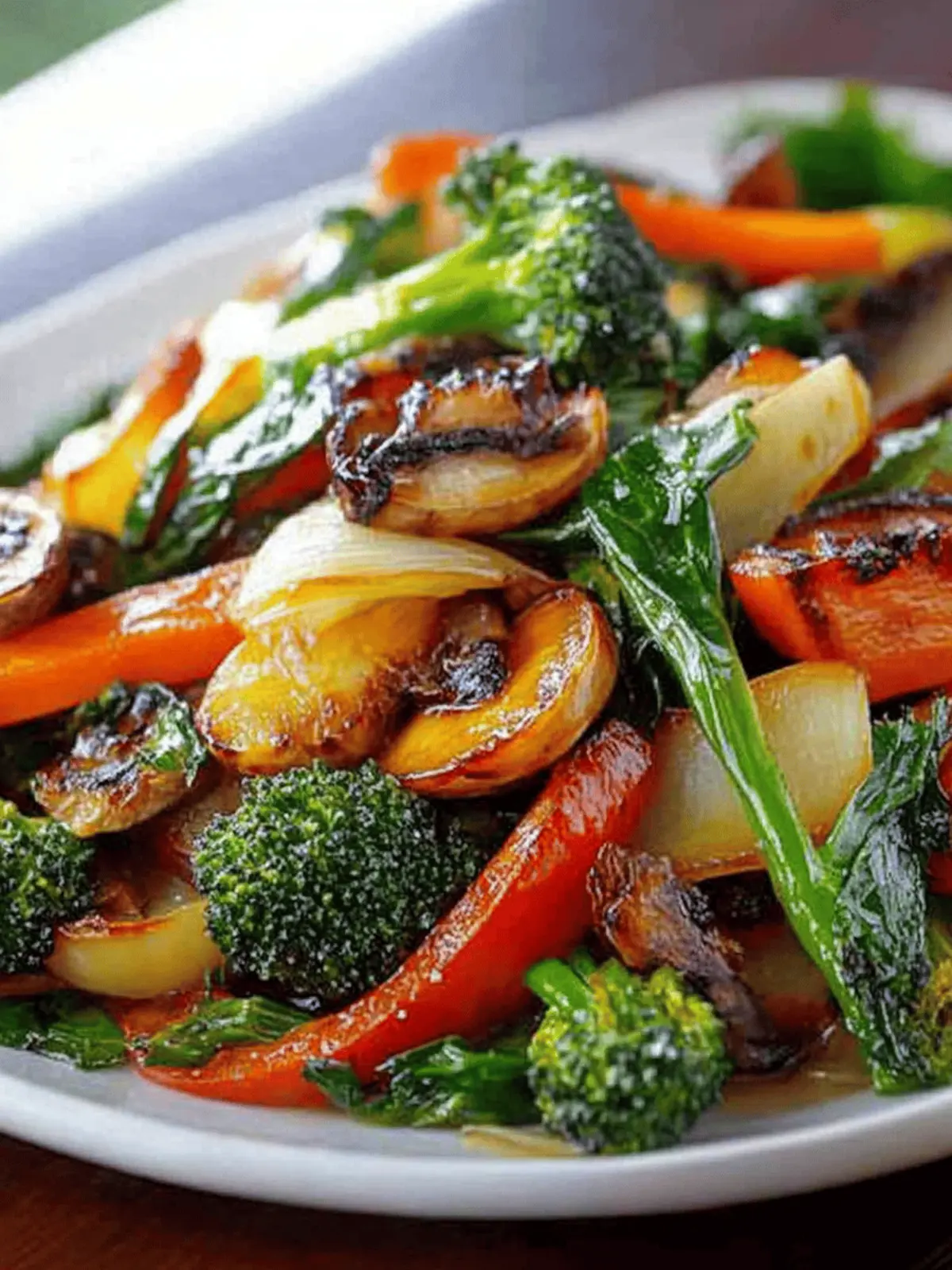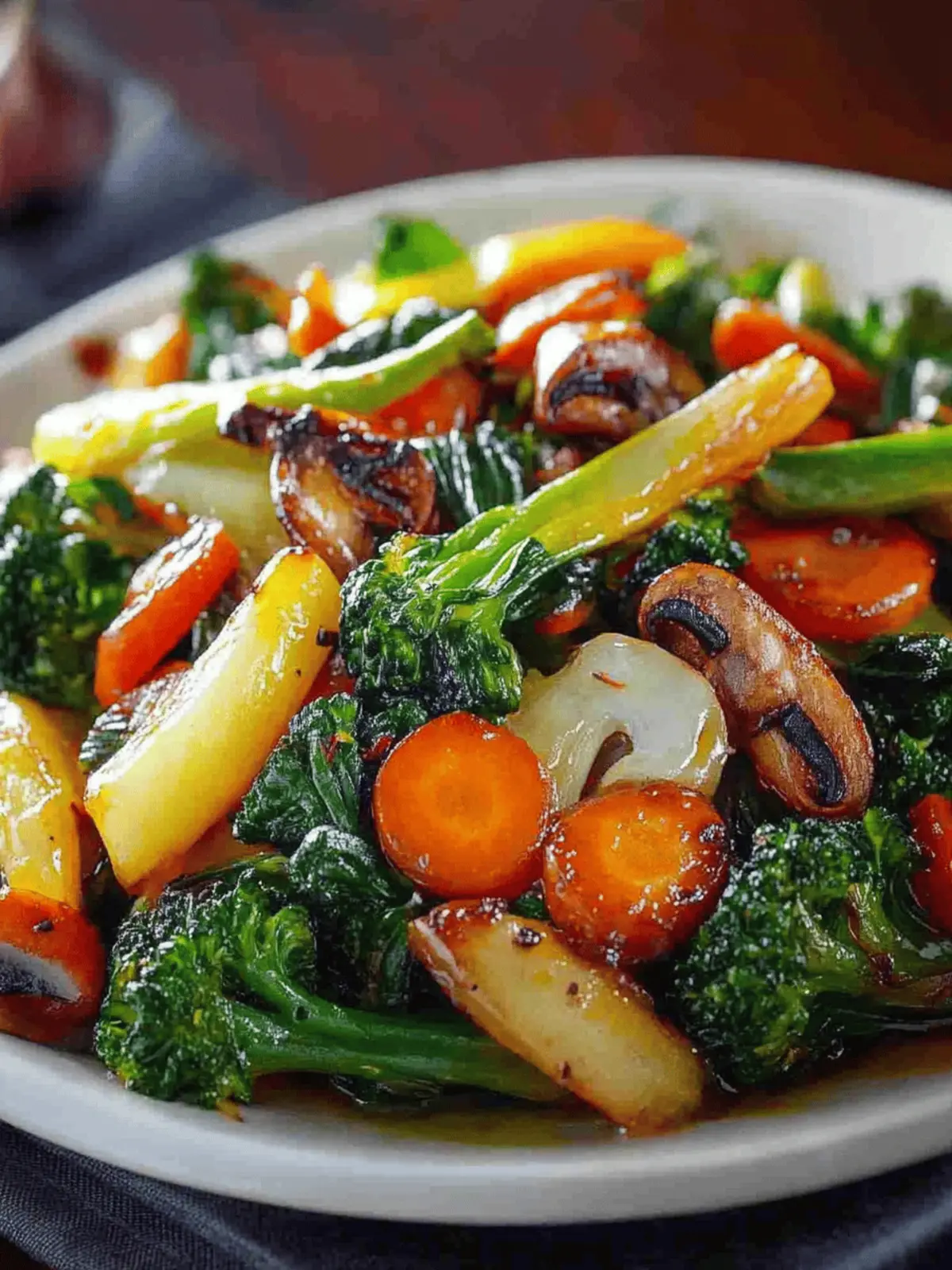The vibrant colors of freshly cut vegetables can instantly elevate a meal, drawing you in with their promise of flavor and nutrition. I often find myself faced with the decision of what to make for dinner after a long day, and that’s when my go-to recipe for Healthy Sautéed Vegetables saves the day. This dish isn’t just a sidekick; it’s a celebration of seasonal produce that comes together in a mere 15 minutes!
As the olive oil warms up in the skillet, the aroma of garlic and onion fills the air, instantly lifting my spirits. Tossing in a mix of bell peppers, zucchini, and snap peas creates an orchestra of crunch and color. What I love most is the versatility—add a splash of lemon juice or a drizzle of balsamic vinegar, and you’ve transformed a simple sauté into a gourmet experience.
Whether you’re a seasoned chef or someone who’s tired of the same takeout routine, you’ll find this recipe not only tantalizes your taste buds but also supports your healthy lifestyle. Let’s dive into how to create this quick, delicious dish that you’ll return to again and again!
Why Choose Healthy Sautéed Vegetables Tonight?
Simplicity: This recipe is quick and easy, making it the perfect solution for busy weeknights.
Bold Flavors: The combination of sautéed garlic and onion with fresh veggies elevates everyday meals.
Customizable: Add your favorite seasonal veggies or experiment with toppings like toasted nuts or grated Parmesan!
Nutrition Boost: Packed with essential vitamins and minerals, this dish is a vibrant and healthy choice.
Crowd-Pleaser: It’s not just a side; serve it as a main dish to impress family or friends!
Time-Saving: With just 15 minutes of cooking, you can enjoy a delicious homemade meal without the wait.
Healthy Sautéed Vegetables Ingredients
• Bring the vibrant flavors to life with these ingredients!
For the Base
• Olive oil – Essential for sautéing and adds a rich flavor.
• Garlic – Minced for a fragrant kick that enhances every bite.
• Onion – Thinly sliced to sweeten and deepen the flavor profile.
For the Vegetables
• Bell pepper – Sliced for a sweet crunch that brightens the dish.
• Zucchini – Cut into half-moons for a tender texture.
• Broccoli florets – Packed with vitamins and adds a beautiful green hue.
• Carrot – Julienned or thinly sliced for a hint of earthiness.
• Snap peas – Their natural sweetness is a delightful surprise.
• Mushrooms – Sliced for umami depth and a hearty bite.
Seasoning and Extras
• Salt and black pepper – Adjust to taste for the perfect seasoning.
• Lemon juice (optional) – A bright note that enhances the flavors of the vegetables.
• Balsamic vinegar or soy sauce (optional) – Adds a savory depth for an extra layer of flavor.
Optional Toppings
• Toasted nuts or seeds – Bring a satisfying crunch and healthy fats.
• Fresh herbs – Use your favorites for a fresh finish.
• Grated Parmesan – A sprinkle adds a savory touch that complements the sautéed vegetables.
With these wholesome ingredients, you’re ready to create a dish that’s not only visually stunning but also embraces the essence of Healthy Sautéed Vegetables!
How to Make Healthy Sautéed Vegetables
-
Prepare the Vegetables: Start by washing, peeling (if necessary), and cutting all your vegetables into uniform pieces. This helps ensure even cooking and a delightful crunch in every bite.
-
Heat the Skillet: Place your skillet over medium-high heat and add the olive oil, letting it warm until shimmering but not smoking. This sets the stage for beautifully sautéed vegetables.
-
Sauté Aromatics: Add minced garlic and sliced onions to the skillet; sauté for 1–2 minutes until fragrant and the onions are slightly translucent. Their savory aroma will fill your kitchen!
-
Cook the Broccoli and Carrots: Toss in the julienned carrots and broccoli florets first. Cook for 3–4 minutes, stirring frequently. Look for tender-crisp textures and vibrant colors.
-
Add Remaining Vegetables: Now, stir in the bell peppers, zucchini, mushrooms, and snap peas. Sauté for another 4–5 minutes until they’re crisp-tender and bright.
-
Season the Dish: Sprinkle salt and pepper over the vegetables, along with the optional lemon juice and balsamic vinegar or soy sauce, if using. This adds layers of flavor that will brighten your dish!
-
Mix and Garnish: Toss everything well to combine and coat the vegetables in seasoning. Serve immediately, garnished with your choice of fresh herbs, toasted nuts, or grated Parmesan for an extra touch!
Optional: For added crunch, sprinkle some toasted pine nuts or pumpkin seeds right before serving.
Exact quantities are listed in the recipe card below.
How to Store and Freeze Healthy Sautéed Vegetables
Fridge: Store leftovers in an airtight container in the refrigerator for up to 3 days. Reheat gently on the stove or in a microwave to preserve texture.
Freezer: You can freeze sautéed vegetables for up to 2 months. Cool them completely, then transfer to a freezer-safe bag or container.
Reheating: For best results, reheat in a skillet over medium heat with a splash of water or broth to regain moisture and freshness.
Serving Tip: To enjoy the flavors of your healthy sautéed vegetables fully, it’s best to eat them fresh, but freezing makes for a quick meal option later!
What to Serve with Healthy Sautéed Vegetables?
A delightful medley of colorful vegetables deserves to be paired with equally vibrant sides to complete your meal.
-
Quinoa Salad: This nutty, protein-packed dish brings a chewy texture and stays light, complementing the crisp veggies perfectly.
-
Garlic Bread: With its crunchy crust and soft inside, it’s the ultimate vehicle for mopping up all the delicious juices from your sautéed vegetables.
-
Lemon Herb Chicken: Juicy and flavorful, this dish harmonizes beautifully with the freshness of the sautéed veggies, creating a balanced meal experience.
-
Brown Rice: Providing a hearty base, brown rice adds a wholesome element while soaking up any extra flavors from the sauté.
-
Roasted Sweet Potatoes: Their natural sweetness contrasts delightfully with the savory veggies, offering a dynamic flavor profile that excites the palate.
-
Crispy Tofu: For a protein-rich twist, crispy tofu lends a satisfying crunch and delightful chew, rounding out a nutritious and delicious dinner.
-
Chilled White Wine: A crisp, chilled glass of Sauvignon Blanc enhances the freshness of your Healthy Sautéed Vegetables, making every bite more enjoyable.
To fully enjoy this marvelous dish, consider these suggestions and share delightful moments around your dinner table!
Expert Tips for Healthy Sautéed Vegetables
-
Even Cuts: Ensure all veggies are cut uniformly to guarantee even cooking, allowing for the perfect balance of tenderness and crunch in your healthy sautéed vegetables.
-
Oil Temperature: Heat your olive oil until it shimmers before adding the garlic and onion. Too cool oil can lead to soggy vegetables instead of that desirable sautéed texture.
-
Stir Frequently: Avoid letting the vegetables sit too long in the pan. Stirring frequently helps them cook evenly and prevents burning, keeping their vibrant colors intact.
-
Layer Flavors: Add your seasonings gradually. Taste as you go, ensuring the perfect balance of salt, pepper, and any optional flavorings like lemon juice or soy sauce to enhance the dish.
-
Serve Immediately: For the best texture and flavor, enjoy your healthy sautéed vegetables right after cooking. They can lose their crunch if left to sit too long!
Healthy Sautéed Vegetables Variations
Customize your healthy sautéed vegetables to elevate your mealtime experience and keep it exciting!
-
Vegan: Swap Parmesan with nutritional yeast for a cheesy flavor without dairy. It’s an easy substitution that adds a nutty richness to the dish.
-
Spicy Kick: Add a pinch of red pepper flakes or sliced jalapeños during cooking for a heat boost. This brings an exciting twist, perfect for spice lovers!
-
Protein-Packed: Toss in cooked chicken, shrimp, or tofu to turn your veggies into a hearty main dish. You’ll enjoy added nutrition and a delightful textural contrast.
-
Root Vegetable Blend: Replace or add sweet potatoes or butternut squash for a sweet, earthy flavor. These additions will create a comforting, hearty dish that’s great for fall.
-
Herb Infusion: Experiment with fresh herbs such as basil, thyme, or rosemary. Toss them in just before serving for a fragrant lift that enhances the overall taste!
-
Citrus Twist: Replace lemon juice with lime juice or orange juice for a fresh, zesty finish. This brightens the dish and offers a new layer of flavor!
-
Gluten-Free: Use gluten-free soy sauce or tamari instead of regular soy sauce for celiacs or gluten-sensitive individuals. It’s a simple swap that ensures everyone can enjoy this dish!
-
Creamy Addition: Stir in a splash of coconut milk or a dollop of sour cream for a creamy twist. This provides a lusciousness that beautifully complements the crisp vegetables.
Make Ahead Options
These Healthy Sautéed Vegetables are a fantastic choice for meal prep, allowing you to enjoy nutritious meals on even the busiest days. You can chop and refrigerate your vegetables up to 24 hours in advance to save time. For optimal freshness, store them in an airtight container with a paper towel to absorb moisture, keeping them crisp. When you’re ready to cook, simply heat the olive oil in your skillet, sauté the garlic and onion, followed by the prepped veggies for 4–5 minutes until bright and tender. Add your seasonings and optional flavorings for a quick, healthy dish that’s just as delicious as fresh!
Healthy Sautéed Vegetables Recipe FAQs
How do I choose the freshest vegetables for this recipe?
Absolutely! When selecting vegetables, look for ones that are vibrant and crisp. Check for dark spots or wilting to avoid any that are past their prime. For green vegetables like broccoli and snap peas, a bright green color indicates freshness.
How long can I store leftovers in the fridge?
You can store leftover Healthy Sautéed Vegetables in an airtight container in the refrigerator for up to 3 days. When ready to enjoy, give them a quick reheat on low heat to maintain their delightful texture.
Can I freeze sautéed vegetables? If so, how?
Yes, you can freeze your Healthy Sautéed Vegetables! Here’s how: Allow them to cool completely after cooking, then transfer them into a freezer-safe bag or container. Squeeze out as much air as possible, label with the date, and store in the freezer for up to 2 months. To reheat, simply microwave or sauté in a pan with a splash of water or broth to help them regain moisture and vibrancy.
What should I do if my vegetables turn mushy when cooking?
Very! If your vegetables turn mushy, it could be due to overcooking or not having the oil hot enough. To fix this in the future, ensure your oil is shimmering before adding vegetables and stir frequently but briefly to maintain that perfect crisp-tender texture. Additionally, cooking them in smaller batches can help them sauté rather than steam.
Are there any allergy considerations for this recipe?
The Healthy Sautéed Vegetables recipe is generally straightforward and free from common allergens. However, if you or your guests have any specific dietary restrictions, make sure to check for individual allergies to ingredients like soy sauce or any nuts you add as toppings. You can easily customize the dish based on personal preferences!
Can I use frozen vegetables instead of fresh?
Absolutely! Frozen vegetables work well for this recipe, especially when fresh produce isn’t available. Just note, you may need to adjust the cooking time slightly, as frozen varieties typically release moisture. Sauté them until heated through and any additional water evaporates, ensuring you still achieve that lovely sautéed flavor and texture.
Enjoy cooking and experimenting with your Healthy Sautéed Vegetables!

Healthy Sautéed Vegetables: A Vibrant Twist on Dinner
Ingredients
Equipment
Method
- Prepare the Vegetables: Start by washing, peeling (if necessary), and cutting all your vegetables into uniform pieces.
- Heat the Skillet: Place your skillet over medium-high heat and add the olive oil, letting it warm until shimmering but not smoking.
- Sauté Aromatics: Add minced garlic and sliced onions to the skillet; sauté for 1–2 minutes until fragrant.
- Cook the Broccoli and Carrots: Toss in the julienned carrots and broccoli florets first and cook for 3–4 minutes.
- Add Remaining Vegetables: Stir in the bell peppers, zucchini, mushrooms, and snap peas. Sauté for another 4–5 minutes.
- Season the Dish: Sprinkle salt and pepper over the vegetables, along with the optional lemon juice and balsamic vinegar if using.
- Mix and Garnish: Toss everything well and serve immediately with your choice of toppings.








